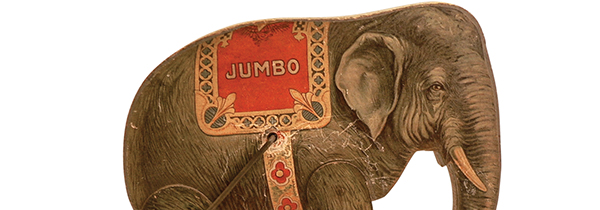 |
 |
||||||||||||||
| DiscoverCreate Act ConnectElephant of the Hour Real-World Science A New Kind of PresidentNewswire A Supporter for the Long HaulTufts DaysThe Big Day Departments |

Elephant of the Hour
125 YEARS OF JUMBO AT TUFTSOn April 3, 1889, the earthly husk of the world’s most famous animal arrived by horse-drawn wagon at the base of Walnut Hill, the home of Tufts College. Jumbo the elephant had weighed more than six tons in life, and now, in overstuffed repose, was too heavy for the horse to pull up the hill. What to do?
“A group of some fifty professors, students, and neighborhood boys was quickly assembled to complete the job,” writes Andrew McClellan, a professor of art and art history, in his new book, Jumbo: Marvel, Myth, and Mascot. But the future icon had no sooner reached the Barnum Museum of Natural History—today’s Barnum Hall—than he hit another snag: his eleven-foot-tall frame wouldn’t fit through the door. The entire entryway had to be dismantled. P.T. Barnum, the founding trustee who had bestowed the remains of his celebrated elephant on Tufts, expressed in a letter to the museum’s curator his hope that “the trouble you have had in putting Jumbo in place will be more than compensated in the advertisement it will give Tufts College.”
Barnum got his wish. Jumbo would lend his name to generations of Tufts sports teams, students, and graduates, not to mention outsize jets, olives, and loans. And now, 125 years after Tufts adopted Jumbo, he is being fêted with an exhibition, a book, and a statue.
The exhibition, arranged by McClellan, shares its title with his book—the companion volume to the show—and runs at the Koppelman Family Gallery in the Aidekman Arts Center until December 7. Its assemblage of photos, postcards, posters, newspaper clippings, and memorabilia tells the story of the gentle giant that was captured as an infant in East Africa in 1862 and shipped to the Paris Zoo and thence to the London Zoo, where he became famous for his size and kindly disposition, cheerfully giving rides to thousands of children, including the young Teddy Roosevelt and Winston Churchill. In 1882, Jumbo was sold for £2,000 (roughly $220,000 in today’s money) to Barnum, with whose circus he toured both sides of the Atlantic. He became a bonafide superstar. Even posthumously, after his fateful run-in with an unscheduled freight train in St. Thomas, Ontario, in 1885, Jumbo’s name and image continued to show up on countless products.
Next spring, Jumbo will be memorialized with a life-size bronze statue commissioned from the artist Stephen Whyte and underwritten by Dick Reynolds, A67, the university’s former vice president of operations. The sculpture, closely modeled on a photo taken at the London Zoo, will be installed in front of Barnum Hall.
As McClellan makes clear in his book, Tufts is lucky to have as its mascot an animal so full of cultural and historical resonance. He writes, “Jumbo’s life intersected with so many important strands of modern American history: the rise of mass entertainment, of museums, of advertising, and the notion of celebrity itself.” —THE EDITORS
To order your copy of Jumbo: Marvel, Myth, and Mascot, Professor Andrew McClellan’s richly illustrated companion volume to the current exhibition on the Medford/Somerville campus, visit Tufts’ eCommerce Marketplace at bit.ly/Jumbo_book.
Watch Jumbo’s story come to life at bit.ly/Jumbo_history.